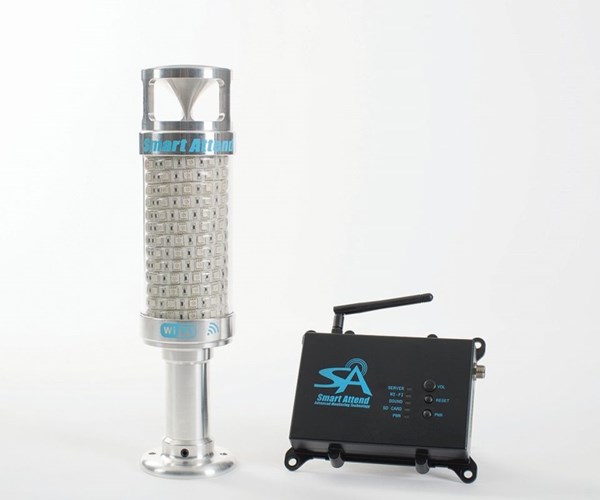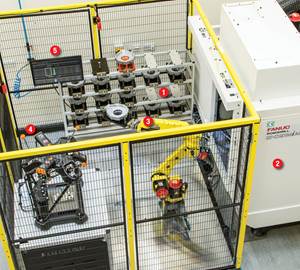This Machine Tool Light Tower Has Digital Capability
Data-driven manufacturing depends on shops being able to collect the data they need to make good decisions about manufacturing processes.
Share





Smart Attend includes a light tower with digital capability for visual and audible signaling on the shop floor, as well as a communication device for data collection and reporting to enable remote production monitoring.
Data-driven manufacturing depends on shops being able to collect the data they need to make good decisions about manufacturing processes. Right now, a lot of attention is devoted to collecting this data from connected devices via a computer network, usually one that uses internet technology to make accessibility to the data almost unlimited. When data is turned into actionable information, people (as well as machines) can respond to situations before workflow is disrupted, a process creates scrap or a danger arises. This is a cornerstone of concepts such as Industry 4.0 and the Industrial Internet of Things (IIoT).
However, critical information about machines on the shop floor can be collected and conveyed by other means that may be simpler, faster and often more effective for achieving certain results. This is the idea behind the Smart Attend “smart light tower.” This device not only provides the expected color-coded light display, but also provides audible indicators such as buzzers, chimes and voice messages. More important, the light tower is also wired to a companion Smart Device that communicates production data wirelessly to a machine-monitoring application running on a cloud-based server. This application enables authorized shop personnel to open a dashboard on a smartphone, tablet or networked PC.
Two principles about Industry 4.0/IIoT implementation are at work here. One is the importance of keeping things simple. The other is the importance of keeping things clear. A light tower with digital functionality supports both principles. Let’s look at simplicity first. The Smart Attend is wired to a machine’s existing 24-volt electrical lines on the I/O board and uses the sensors already on the machine. Because hookup is designed to be simple, the system can be installed on critical accessories or auxiliary equipment in addition to CNC machines. For example, a light tower on a shop’s central air compressor can detect if line pressure drops too low and issue the appropriate alert. Legacy machines or older equipment without electronic control systems can also be equipped with a light tower and communication box.
Installation requires no software interface or communication protocol to link to the Smart Device’s network portal, which feeds the shop’s unique account that is set up on the server. When logged onto this account, users can configure settings that identify what data should be collected and analyzed. By design, this data is limited to basic information about run time, setup, downtime, and other alarm states or conditions that the user selects. The graphs, pie charts and reports generated by the application are designed for at-a-glance interpretation, thereby avoiding the data-overload syndrome that sometimes traps shops with machine-monitoring systems interfaced to CNC units. Keeping production reporting simple and clear helps make responses more timely and straightforward. A memory card in the communication box serves as a backup to record data if the network connection is disrupted.
Digital functionality is likewise the key to clarity of live, shopfloor messaging. Visually, the array of light-emitting diodes in the light tower can be configured for a variety of solid colors, as well as flash or strobe effects to indicate machine status and alarm conditions. Visually scanning a production area to see the status of each machine can be a simple but powerful tool for communication. Adding an audible function to a light tower can also direct attention to a machine and help summon the right resources to prevent or reduce downtime. The integrated sound diffuser on the light tower can be configured to emit tones, buzzers and/or WAV files of prerecorded voice messages, chimes or melodies. The intent is to make this messaging unmistakable on the shop floor. Notifications can be set to escalate, that is, be configured so an alarm triggers a sequence that moves from lights to buzzers to emails and mobile messages that go up a chain of command until a response is forthcoming. The timing for each step can be set as desired.
Although a light tower may seem “old school,” a smart version with digital capability represents a practical approach to data-driven manufacturing—the new school of thought for managing the shop or plant.
Related Content
5 Stages of a Closed-Loop CNC Machining Cell
Controlling variability in a closed-loop manufacturing process requires inspection data collected before, during and immediately after machining — and a means to act on that data in real time. Here’s one system that accomplishes this.
Read MoreSwiss-Type Control Uses CNC Data to Improve Efficiency
Advanced controls for Swiss-type CNC lathes uses machine data to prevent tool collisions, saving setup time and scrap costs.
Read MoreEasy-To-Install Data Acquisition System for Real-Time Monitoring Across Brands
cnSEE from All World Machinery Supply combines easy installation and monitoring across multiple machines.
Read MoreLeveraging Data to Drive Manufacturing Innovation
Global manufacturer Fictiv is rapidly expanding its use of data and artificial intelligence to help manufacturers wade through process variables and production strategies. With the release of a new AI platform for material selection, Fictive CEO Dave Evans talks about how the company is leveraging data to unlock creative problem solving for manufacturers.
Read MoreRead Next
5 Rules of Thumb for Buying CNC Machine Tools
Use these tips to carefully plan your machine tool purchases and to avoid regretting your decision later.
Read MoreBuilding Out a Foundation for Student Machinists
Autodesk and Haas have teamed up to produce an introductory course for students that covers the basics of CAD, CAM and CNC while providing them with a portfolio part.
Read MoreSetting Up the Building Blocks for a Digital Factory
Woodward Inc. spent over a year developing an API to connect machines to its digital factory. Caron Engineering’s MiConnect has cut most of this process while also granting the shop greater access to machine information.
Read More






















.jpg;maxWidth=300;quality=90)







